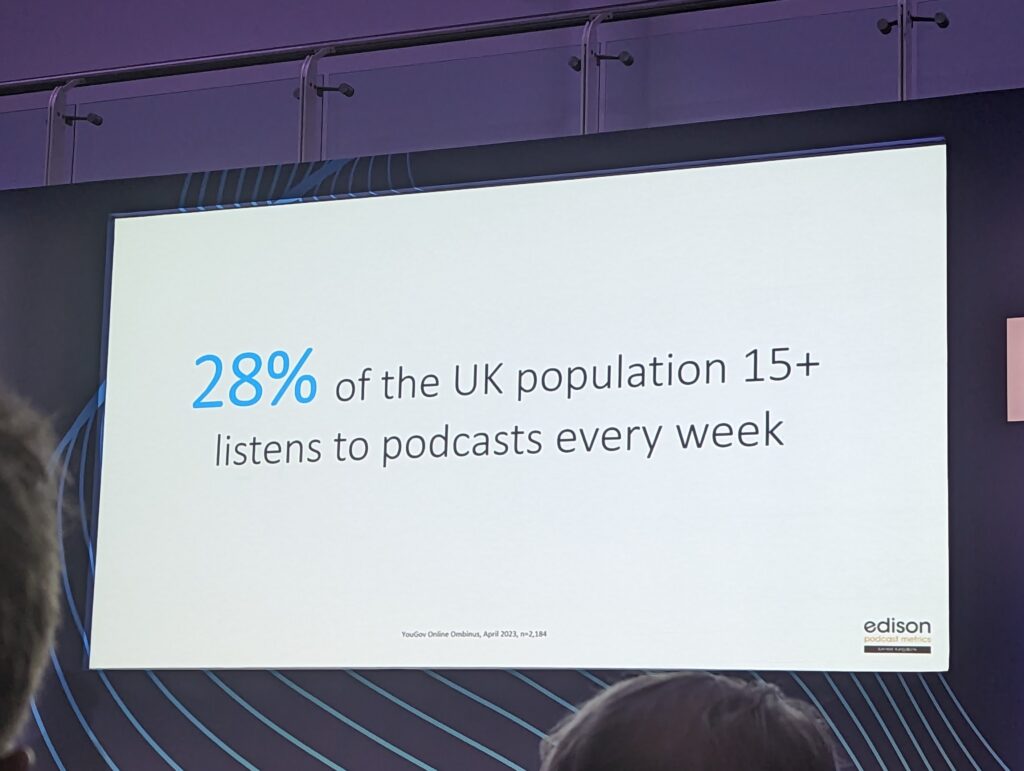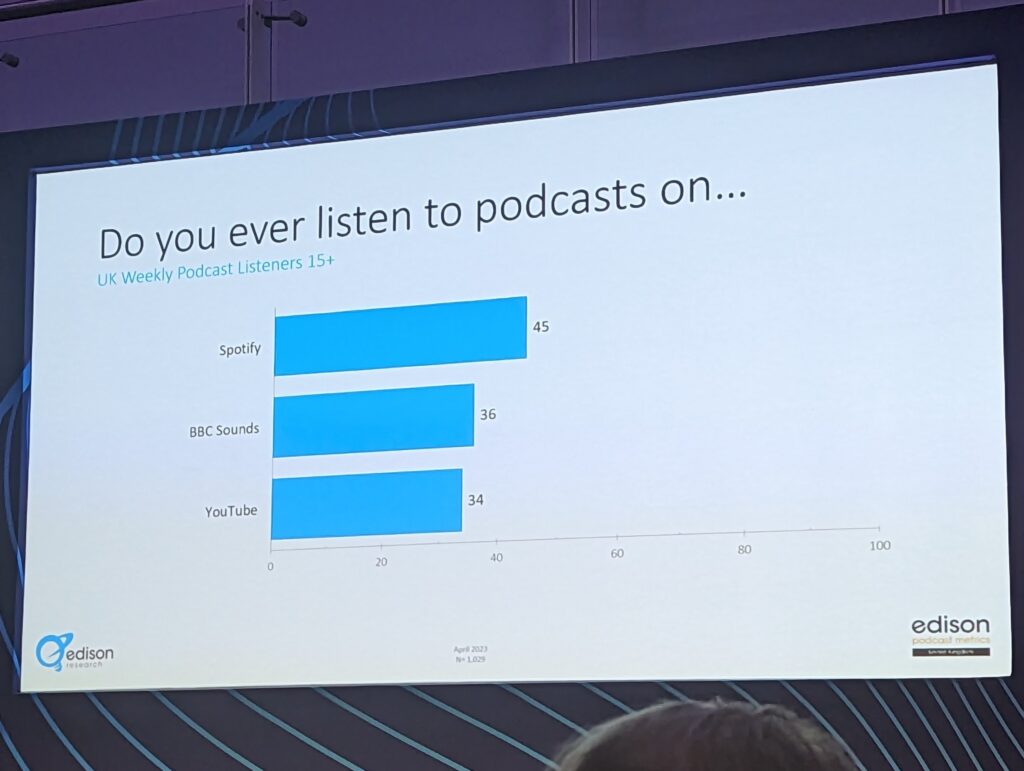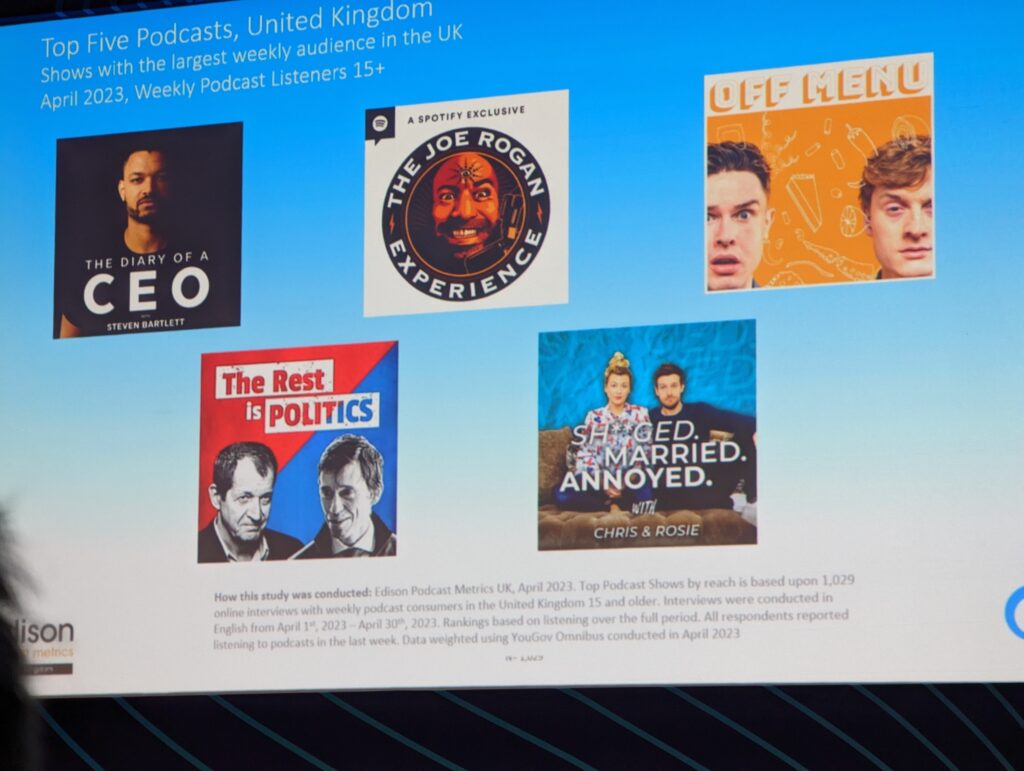This week I’ve been at the London Podcast Show 2023, and I’ll write more about that in another entry. But one of the big announcements that came out of the event was that Edison Research is launching their Edison Podcast Metrics in the UK.
In the US, Edison Research has been producing what have effectively become the industry standard research metrics for podcasting. They survey podcast listeners to collate, not just overall figures for podcast listening in their Infinite Dial releases and wider Share of Ear (which measures all forms of audio), but also capture a full picture of the most listened to podcasts, and demographic data for those podcasts.
They release a certain amount of data for anyone to look at and use – and as a consequence, it’s a rare podcast industry presentation that doesn’t contain one of their slides.
Gabriel Soto, Edison’s Senior Director of Research was presenting in London, and he shared this slide which is very familiar, and can be found in their most recent US Infinite Dial research.

Essentially it shows that 31% of the US 12+ population listens to podcasts each week, representing around 89 million people. (The dip in 2022 is basically a return to normal growth from the massive pandemic bump felt especially in the 2021 data).
Gabriel announced that the first full data release would be coming in Q3 2023 in the UK, when I’ve no doubt that Edison will release a decent amount of topline research, whilst reserving other data for paying subscribers. Research is expensive after all, and someone has to pay!
In a separate press release Edison notes that, “Subscribers will have the ability to analyze demographics of podcast listeners including their purchasing and consumption patterns across a wide range of consumer goods and services.”
At the event, Gabriel did give us an early flavour of the research. They have yet to complete full fieldwork, hence the big data release coming later in the year, but in the meantime, they released some early data based on a smaller sample size of respondents.

Their first finding is that 28% of the 15+ population listens to podcasts each week. We’ll come back to that number.
The general idea is that Edison Research will use a consistent methodology between different countries that will allow UK data to be compared with their US data.
Gabriel in particular highlighted that listening location is significantly different in the UK compared to the US, even with the small sample that this early data is based on.

This side of the Pond we’re more likely to listen whilst we’re outdoors – perhaps walking or running – than US citizens.
And of course, we have the BBC in the UK.

Note that we’re only talking about 1,000 respondents here, but it’s notable that Apple Podcasts isn’t on this chart. Perhaps it’s just behind YouTube and was left off?
Anyway, BBC Sounds is a significant podcast player in the UK (Leaving aside the determination of whether non-RSS audio can be called a “podcast”).
I think this was the most interesting slide that attendees were shown. These are the top five podcasts, based on recall in April 2023.

It’s worth noting that these are in no particular order since Edison doesn’t feel that it has a big enough sample size to place them in order definitively.
For clarity, the titles are:
- The Diary of a CEO with Steven Bartlett
- The Joe Rogan Experience
- Off Menu with Ed Gamble and James Acaster
- The Rest is Politics with Alistair Campbell and Rory Stewart
- Sh**ged, Married, Annoyed with Chris and Rosie Ramsey
Those titles definitely pass the “sniff” test, although I’ve yet to meet someone in the UK who really does listen to Joe Rogan (I may just be too old to know any such person).
The BBC recently announced that on BBC Sounds, I’m Not A Monster – The Shamima Begum Story was its most listened to podcast overall during Q1. But it was released in January, so may have peaked prior to this research being done.
It’s certainly noticeable that all the titles in Edison Research’s list release pretty much year-around.
Edison didn’t share anything else about their UK findings, so we will need to wait until later in the year for their full dataset about UK podcast listening.
But that does mean that we now have at least three separate sources for podcast research:
- RAJAR – who primarily measure radio, but also measure podcast listening and release regular MIDAS survey updates (there are some topline podcast findings from the latest MIDAS research here)
- Ofcom – who release a very comprehensive annual survey (I summarise it here)
- Edison Research – who will release a comprehensive survey with additional data for subscribers
Each uses slightly different methodologies to capture their data. Even aside from differences in how fieldwork is collected, and how much you prompt respondents to ensure that they’re telling you the right thing, how you even define a “podcast” can vary between surveys. There are also differences in which audiences are measured, and any weighting that is applied to data. Is the data collected in person? Via the phone? Online? All have pros and cons. What language was the survey available in? Were there any incentives offered?
These are all challenges in all kinds of research fieldwork, but if you ask the same question in different ways to different sets of people, then you will get different answers.
With all that said, it’s interesting to see how the most recent podcast listening data from RAJAR, Ofcom and now Edison Research compares. Note that there’s only one figure that we can compare across the three surveys – weekly podcast listening.
Note: Reiterating the above. Different methodologies. Different sample sizes. Different survey periods. Not directly comparable. All numbers rounded up or down to the nearest percentage point.
Which figure is right?
All of them.
Expect to see different people use different figures in the wild. All use legitimate fieldwork companies to capture the data. The key thing will probably be consistency between surveys. RAJAR and Ofcom have both released datasets that basically capture their figures in the same manner each year. If you change the way you ask people, or indeed the methodology too much between waves of data, then you can skew your results.
Edison Research too has consistently collected data in a consistent manner in the US (and other countries) over time, as the chart above showing US podcast listening back to 2013 shows.
So do we actually need three (or more) groups measuring UK podcast listening?
I think it’s actually quite useful not to have a single source of data. If we were talking about ratings then yes, a single source, agreed by the entire industry would make sense. Radio has RAJAR; TV has BARB.
But this isn’t currency research. Edison might be able to measure the biggest podcasts in the UK, but it can’t measure the smallest ones, because even with large samples, they’re not going to be big enough to measure everything.
RAJAR does keep some of its MIDAS data exclusive to its subscribers, as Edison Research will. Ofcom on the other hand, as a media regulator, releases its full data tables online for all to see.
On the other hand, to date it really hasn’t been possible to examine, say, the profiles of other podcasts. Podcast producers might have access to profiles of their own data from, say, Spotify. But you can’t necessarily extrapolate that data to your entire listenership because Spotify skews slightly younger than average. Unless you conduct your own expensive research, you really don’t know for certain. That’s USP of what Edison Research will be offering.
As I’ve said, Ofcom and RAJAR have both released consistent data over time that shows growth of podcasting. While I’m sure that Edison Research plans to be working in the UK for a while yet, I would note that having launched a UK version of The Infinite Dial back in 2021, they didn’t repeat the exercise in 2022 (I assume because Bauer and Spotify who sponsored that release didn’t both return to the table).
Anyway, I wish Edison Research good luck with their Podcast Metrics UK. The more data the better!

